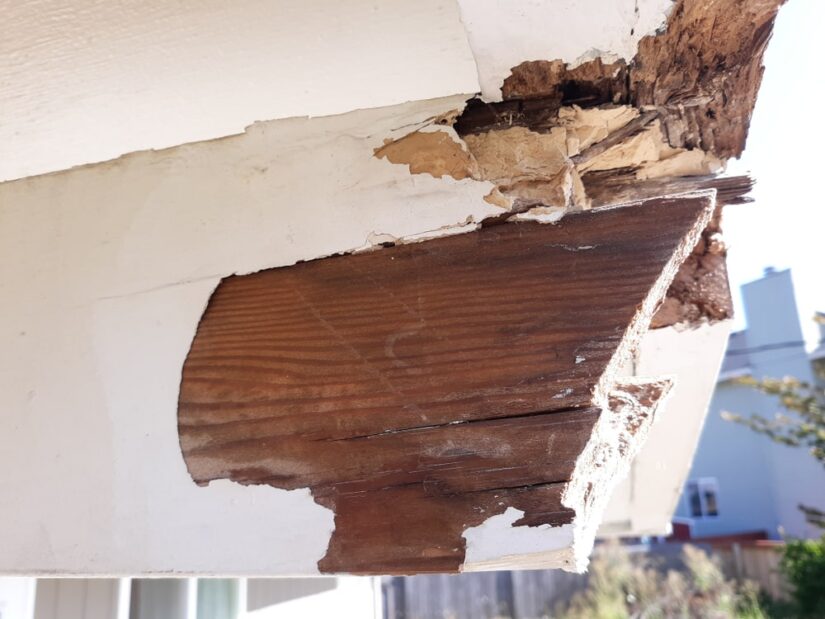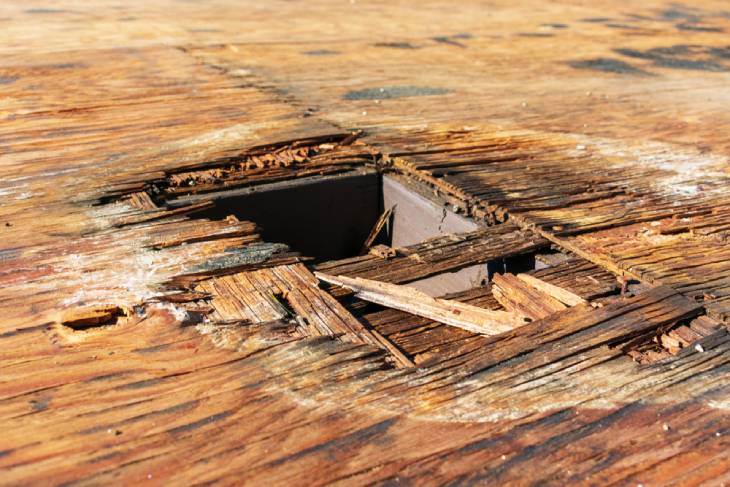
Wood rot is a common issue that many homeowners encounter, often leading to significant damage if left unaddressed. Dry rot and wet rot differ fundamentally in their causes and impacts. Dry rot is caused by a specific type of fungus that requires minimal moisture to thrive, while wet rot occurs when wood remains damp for an extended period, usually over 20% moisture content.
Understanding these differences is crucial for effective prevention and treatment. Dry rot can spread through masonry and brickwork, making it more destructive over larger areas, whereas wet rot tends to remain confined to moist areas. Rot repair services will be needed to take care of either type of wood rot.
Fundamentals of Wood Rot
Defining Dry Rot and Wet Rot
Dry rot and wet rot are two primary forms of fungal decay in wood. Dry rot arises from Serpula lacrymans fungus, known for causing severe damage by consuming the moisture in the wood. It breaks the wood down from the inside, leaving a brittle surface. In contrast, wet rot results from fungi like Coniophora puteana and relies on an ample presence of moisture to flourish.
Wet rot can occur where wood consistently remains damp, such as around leaks. The decay makes the wood soft and crumbly, with a darker color. Both types can significantly impact wooden structures, leading to costly repairs if not addressed promptly.
Common Causes of Wood Decay
Wood decay is primarily caused by moisture interacting with fungi in the presence of oxygen. Persistent dampness, due to leaks or poor insulation, creates an ideal environment for these fungi. Inadequate ventilation in crawl spaces or basements often exacerbates moisture retention, accelerating decay.
Building materials or techniques that allow water ingress increase the susceptibility to rot. Improperly sealed wood, poor drainage, or lack of maintenance can contribute to moisture buildup, making wood vulnerable.
Protective measures, such as using treated timber and ensuring adequate air circulation, can mitigate these risks. Regular inspections and maintenance play a critical role in spotting early signs of decay and preventing extensive damage.
The Biological Mechanisms Behind Rot
The process begins when fungal spores land on damp wood and germinate. Moisture is critical to fungal growth, enabling spores to spread. Fungi digest cellulose and hemicellulose, essential components of wood structure, by secreting enzymes.
Dry rot employs efficient mechanisms to transport moisture from wet areas to dry regions, facilitating spread. This ability allows it to thrive even in drier conditions compared to wet rot. In wet rot, fungi primarily attack areas with sufficient moisture, limiting their reach.
The breakdown of cellulose weakens the wood, causing structural compromises. Understanding these biological mechanisms assists in identifying and managing wood decay effectively. Early intervention remains key in preserving wooden structures against these destructive processes.
Identification of Dry Rot and Wet Rot
Visual Differences
Dry rot usually appears as a yellow or white growth on wood surfaces. In advanced stages, it can develop into a mushroom-like fruiting body. The wood often lacks structural integrity, appearing cracked and brittle. Contrast that with wet rot, which tends to look darker due to moisture absorption. It often appears as a black, soft mass on surfaces.
Signs of wet rot include localized discoloration and the presence of a damp, musty smell. The affected areas may be bloated or swollen due to excessive moisture content.
Tactile Characteristics
The tactile qualities of dry and wet rot are distinctive. Dry rot feels crumbly and brittle due to the lack of moisture. It may flake off easily when touched. This fragility helps distinguish dry rot from its counterpart.
Wet rot feels soft, spongy, and often damp. The wood typically retains moisture, making it less flaky but more amenable to compression. The texture of wet rot wood may vary depending on how much of the wood has been affected by moisture.

Environmental Conditions Fostering Each Type of Rot
The conditions under which dry and wet rot thrive also differ. Dry rot prefers low moisture environments, flourishing in areas where water intrusion is minimized but still enough to sustain fungal growth. Ventilation and a humidity level below 20% are conducive to dry rot.
Wet rot thrives in high-moisture conditions, typically found in areas plagued by leaks or poor drainage. Wood constantly exposed to moisture above 20% is susceptible to wet rot. Common sites include bathrooms, kitchens, and places with defective plumbing or drainage.
Prevention and Treatment Strategies
Preventive Measures for Dry and Wet Rot
Proper ventilation and humidity levels are crucial steps in preventing rot. Ensure good air circulation in crawlspaces and attics. Use dehumidifiers to manage moisture levels in susceptible areas.
Regular insulation checks can manage temperature fluctuations. Protect timber by treating it with preservatives and ensuring any leaks or damages in plumbing and roofing are promptly repaired. This minimizes conditions conducive to rot development.
Monitoring for early signs of rot, such as discolored or damp wood, is practical. Schedule routine inspections to catch potential problems before they escalate into more severe damage.
Treating Dry Rot
To treat dry rot, identify and remove affected wood with care. Replace timbers when necessary to ensure structural integrity. Fungicidal treatments are effective in treating the remaining areas, preventing further decay.
Address the source of moisture to prevent recurrence. Allow timber to dry completely; use industrial fans or dehumidifiers where needed. Seal and protect exposed wood with appropriate finishes or coatings.
You should control the environmental conditions surrounding the affected area to prevent future infestations. Regular inspections post-treatment ensure no remaining traces of rot persist.
Treating Wet Rot
Treatment for wet rot focuses on addressing moisture issues as the primary strategy. First, repair leaks in plumbing and roofing. Dry out damp areas thoroughly using fans or heaters.
Remove damaged wood and replace it with treated timber to maintain strength. In some instances, wood hardeners may restore structural capability for less severe cases. Ensure improved ventilation in affected areas to avoid damp conditions reoccurring.
Apply fungicidal treatment products to treated areas to deter further fungal activity. Following treatment, implement preventive measures to stop the conditions that favor the growth of wet rot from returning. Use environmentally safe products where possible to meet health standards.
Impact and Implications of Wood Rot
Structural Implications
Wood rot weakens the foundational elements of a structure. Dry rot typically spreads across large areas, feeding off moisture-laden wood, compromising beams, floors, and walls.
By contrast, wet rot demands consistently damp conditions, initially affecting localized spots before causing structural damage. Both forms of rot threaten safety, leading to costly repairs or potential collapse. Identifying early signs like discoloration or softness can reduce these risks.
Economic Considerations
Addressing wood rot can be expensive, particularly if not detected early. Homeowners may face high repair bills, including labor costs and material replacements.
Issues like dry rot, notorious for its aggressiveness, often necessitate extensive renovation work. Wet rot, while limited to moisture-prone areas, still incurs costs due to frequent exposure to water sources.
Preventative measures, which include regular inspections and maintaining adequate ventilation, offer a more cost-effective approach. Recognizing the financial impact encourages timely intervention, ultimately saving money and preserving property value.
Long-Term Prevention and Maintenance
Long-term strategies focus on preventing moisture buildup and ensuring proper ventilation. Regularly checking areas susceptible to dampness, such as basements and bathrooms, helps mitigate the risk of wet rot.
Sealants and protective coatings can be applied to vulnerable wood surfaces, providing barriers against moisture. For dry rot, maintaining low humidity levels is crucial, necessitating dehumidifiers and adequate airflow in enclosed spaces.